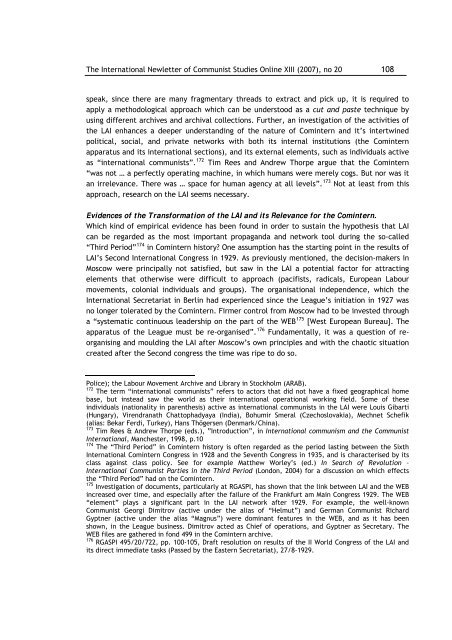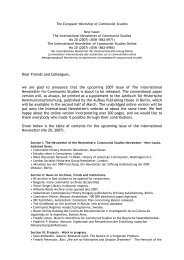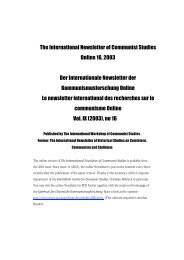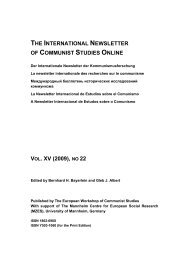Vol. XIII (2007), no 20 - The International Newsletter of Communist ...
Vol. XIII (2007), no 20 - The International Newsletter of Communist ...
Vol. XIII (2007), no 20 - The International Newsletter of Communist ...
Sie wollen auch ein ePaper? Erhöhen Sie die Reichweite Ihrer Titel.
YUMPU macht aus Druck-PDFs automatisch weboptimierte ePaper, die Google liebt.
<strong>The</strong> <strong>International</strong> Newletter <strong>of</strong> <strong>Communist</strong> Studies Online <strong>XIII</strong> (<strong><strong>20</strong>07</strong>), <strong>no</strong> <strong>20</strong> 108<br />
speak, since there are many fragmentary threads to extract and pick up, it is required to<br />
apply a methodological approach which can be understood as a cut and paste technique by<br />
using different archives and archival collections. Further, an investigation <strong>of</strong> the activities <strong>of</strong><br />
the LAI enhances a deeper understanding <strong>of</strong> the nature <strong>of</strong> Comintern and it’s intertwined<br />
political, social, and private networks with both its internal institutions (the Comintern<br />
apparatus and its international sections), and its external elements, such as individuals active<br />
as “international communists”. 172 Tim Rees and Andrew Thorpe argue that the Comintern<br />
“was <strong>no</strong>t … a perfectly operating machine, in which humans were merely cogs. But <strong>no</strong>r was it<br />
an irrelevance. <strong>The</strong>re was … space for human agency at all levels”. 173 Not at least from this<br />
approach, research on the LAI seems necessary.<br />
Evidences <strong>of</strong> the Transformation <strong>of</strong> the LAI and its Relevance for the Comintern.<br />
Which kind <strong>of</strong> empirical evidence has been found in order to sustain the hypothesis that LAI<br />
can be regarded as the most important propaganda and network tool during the so-called<br />
“Third Period” 174 in Comintern history? One assumption has the starting point in the results <strong>of</strong><br />
LAI’s Second <strong>International</strong> Congress in 1929. As previously mentioned, the decision-makers in<br />
Moscow were principally <strong>no</strong>t satisfied, but saw in the LAI a potential factor for attracting<br />
elements that otherwise were difficult to approach (pacifists, radicals, European Labour<br />
movements, colonial individuals and groups). <strong>The</strong> organisational independence, which the<br />
<strong>International</strong> Secretariat in Berlin had experienced since the League’s initiation in 1927 was<br />
<strong>no</strong> longer tolerated by the Comintern. Firmer control from Moscow had to be invested through<br />
a “systematic continuous leadership on the part <strong>of</strong> the WEB 175 [West European Bureau]. <strong>The</strong><br />
apparatus <strong>of</strong> the League must be re-organised”. 176 Fundamentally, it was a question <strong>of</strong> reorganising<br />
and moulding the LAI after Moscow’s own principles and with the chaotic situation<br />
created after the Second congress the time was ripe to do so.<br />
Police); the Labour Movement Archive and Library in Stockholm (ARAB).<br />
172<br />
<strong>The</strong> term “international communists” refers to actors that did <strong>no</strong>t have a fixed geographical home<br />
base, but instead saw the world as their international operational working field. Some <strong>of</strong> these<br />
individuals (nationality in parenthesis) active as international communists in the LAI were Louis Gibarti<br />
(Hungary), Virendranath Chattophadyaya (India), Bohumir Smeral (Czechoslovakia), Mechnet Schefik<br />
(alias: Bekar Ferdi, Turkey), Hans Thögersen (Denmark/China).<br />
173<br />
Tim Rees & Andrew Thorpe (eds.), ”Introduction”, in <strong>International</strong> communism and the <strong>Communist</strong><br />
<strong>International</strong>, Manchester, 1998, p.10<br />
174<br />
<strong>The</strong> “Third Period” in Comintern history is <strong>of</strong>ten regarded as the period lasting between the Sixth<br />
<strong>International</strong> Comintern Congress in 1928 and the Seventh Congress in 1935, and is characterised by its<br />
class against class policy. See for example Matthew Worley’s (ed.) In Search <strong>of</strong> Revolution –<br />
<strong>International</strong> <strong>Communist</strong> Parties in the Third Period (London, <strong>20</strong>04) for a discussion on which effects<br />
the “Third Period” had on the Comintern.<br />
175<br />
Investigation <strong>of</strong> documents, particularly at RGASPI, has shown that the link between LAI and the WEB<br />
increased over time, and especially after the failure <strong>of</strong> the Frankfurt am Main Congress 1929. <strong>The</strong> WEB<br />
“element” plays a significant part in the LAI network after 1929. For example, the well-k<strong>no</strong>wn<br />
<strong>Communist</strong> Georgi Dimitrov (active under the alias <strong>of</strong> “Helmut”) and German <strong>Communist</strong> Richard<br />
Gyptner (active under the alias “Magnus”) were dominant features in the WEB, and as it has been<br />
shown, in the League business. Dimitrov acted as Chief <strong>of</strong> operations, and Gyptner as Secretary. <strong>The</strong><br />
WEB files are gathered in fond 499 in the Comintern archive.<br />
176<br />
RGASPI 495/<strong>20</strong>/722, pp. 100-105, Draft resolution on results <strong>of</strong> the II World Congress <strong>of</strong> the LAI and<br />
its direct immediate tasks (Passed by the Eastern Secretariat), 27/8-1929.














